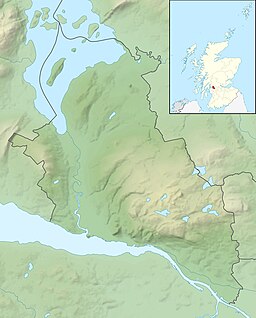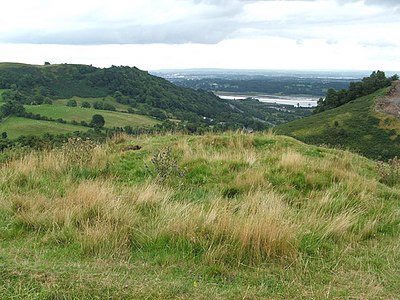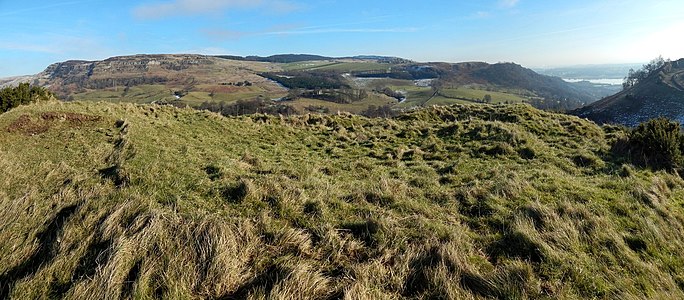| Loch Bowie | |
|---|---|
 Loch Bowie. The small hill behind is the medieval fort of Dunbowie Dun. Loch Bowie. The small hill behind is the medieval fort of Dunbowie Dun. | |
 | |
| Location | West Dunbartonshire, Scotland |
| Coordinates | 55°56′40″N 4°31′25″W / 55.9444°N 4.52354159°W / 55.9444; -4.52354159 |
| Type | freshwater loch |
| River sources | River Kirkaig |
| Ocean/sea sources | Atlantic Ocean |
| Basin countries | Scotland |
| Max. length | 180 m (590 ft) |
| Max. width | 100 m (330 ft) |
| Surface area | 2.9 ha (7.2 acres) |
| Shore length | 700 m (2,300 ft) |
| Surface elevation | 83 m (272 ft) |
| Settlements | Dumbarton |
| Shore length is not a well-defined measure. | |
Loch Bowie is a small freshwater loch located in West Dunbartonshire, Scotland.
Geography
To the west of the Loch is the former Iron Age Hillfort of Dunbowie Dun, a volcanic plug on the edge of the Kilpatrick Hills plateau, that overlooks the loch at 158 metres (518 ft). The town of Dumbarton is directly to the west. To the south is Dumbuck Hill, which is now Dumbuckhill Quarry. To the southeast is the Chapel of Colquhoun. The mound is from a volcanic plug on the edge of the Kilpatrick Hills plateau called Chapel Knowe. In the centre of the mound there is the appearance of the foundations of a small building, and in earlier times was used as a place of sepulture. A tradition is held amongst people in Dumbarton that a chapel formerly stood on the mound that part of the walls from about 100 years ago remained. Within this century, tombstones have been excavated from the ground on the Chapel Knowe. Chapel Knowe nor Muir of Colquhoun has not been found on any plan. Closer to the east, is the former castle of Middleton Castle that later became a farm. The Lorane family were tenants of Middleton for centuries, and by 1810 the castle, which had 4-foot (1.2 m) high walls, was in ruins.
To the north along the rural road that passes the loch to the right is Overtoun House.
Gallery
-
 Dumbowie Hill has two summits, north-western summit and south-eastern summit
Dumbowie Hill has two summits, north-western summit and south-eastern summit
-
 The flat area on the summit was the site of Dumbuie Dun, an Iron Age fort, the antiquity marked on the map.
The flat area on the summit was the site of Dumbuie Dun, an Iron Age fort, the antiquity marked on the map.
See also
References
- Microsoft; Nokia. "Loch Bowie" (Map). Bing Maps. Microsoft. Retrieved 22 November 2017.
- "Loch Bowie". Centre for Ecology and Hydrology. Scotland and Northern Ireland Forum for Environmental Research (SNIFFER). Retrieved 18 August 2020.
- ^ John Scot, Bruce (1893). The history of the parish of West or Old Kilpatrick and of the church and certain lands in the parish of East or New Kilpatrick. Royal Commission on the Ancient and Historical Monuments of Scotland: British Library, Historical Print Editions. Retrieved 19 February 2018.
- "Middleton". Canmore National Record of the Historic Environment. Historic Environment Scotland. Retrieved 19 February 2018.
This Scottish location article is a stub. You can help Misplaced Pages by expanding it. |